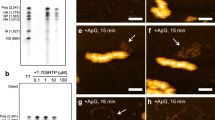Summary
The synthesis of virus-specific RNA in Newcastle disease virus-infected cells is strongly suppressed by amino acid analogues (p-fluorophenylalanine, ethionine and canavanine) if they are present throughout the reproduction cycle or added 2–4 hours p.i. The analogues exert only a partial inhibitory effect when added 6 hours p.i. Virus-specific RNA synthesized in cells exposed to ethionine or canavanine has essentially the same sedimentational pattern as RNA formed in the absence of the analogues, whereas p-fluorophenylalanine preferentially inhibits 35S RNA accumulation. The content of “minus” strands in different RNA classes is not changed in p-fluorophenylalanine-treated cells. 50S RNA formation, although readily suppressed by cycloheximide was not inhibited by the amino acid analogues tested.
Similar content being viewed by others
References
Baltimore, D.: Replication of picornaviruses. In: “The Biochemistry of Viruses” (H. B. Levi, ed.), pp. 101–176, New York: Decker, 1969.
Blair, C. D., andW. S. Robinson: Replication of Sendai virus. I. Comparison of viral RNA and virus-specific RNA synthesis to Newcastle disease virus. Virology35, 537–549 (1968).
Bratt, M. A., andW. S. Robinson: Ribonucleic acid synthesis in cells infected with Newcastle disease virus. J. molec. Biol.23, 1–21 (1967).
Clavell, L. A., andM. A. Bratt: The relationship between the RNA-synthetizing capacity of UV-irradiated NDV and its ability to induce interferon. J. Virol.8, 500–512 (1971).
Duesberg, P. H., andW. S. Robinson: Isolation of the nucleic acid of Newcastle disease virus. Proc. nat. Acad. Sci. (Wash.)54, 794–800 (1965).
Dulbecco, R., andM. Vogt: Plaque formation and isolation of pure lines with poliomyelitis viruses. J. exp. Med.99, 167–182 (1954).
East, J. L., andD. W. Kingsbury: Mumps virus replication in chick embryo lung cells: properties of ribonucleic acid in virions and infected cells. J. Virol.8, 171–179 (1971).
Huang, A. S., D. Baltimore, andM. A. Bratt: Ribonucleic acid polymerase in virions of Newcastle disease virus: comparison with the vesicular stomatitis virus. J. Virol.7, 389–394 (1971).
Katz, L., andS. Penman: The solvent denaturation of double-stranded RNA from poliovirus-infected HeLa cells. Biochem. biophys. Res. Commun.23, 557–559 (1966).
Kaverin, N. V., andN. L. Varich: Virus-specific RNA formed in Newcastle disease virus-infected cells after suppression of protein synthesis by cycloheximide. Arch. ges. Virusforsch.35, 378–384 (1971).
Kingsbury, D. W.: Newcastle disease virus. I. Isolation and preliminary characterization of RNA from virus particles. J. molec. Biol.18, 195–203 (1966a).
Kingsbury, D. W.: Newcastle disease virus. II. Preferential synthesis of RNA complementary to parental viral RNA by chick embryc cells. J. molec. Biol.18, 204–214 (1966b).
Robinson, W. S.: Sendai virus RNA synthesis and nucleocapsid formation in the presence of cycloheximide. Virology44, 494–502 (1971).
Author information
Authors and Affiliations
Rights and permissions
About this article
Cite this article
Kaverin, N.V., Varich, N.L. & Smirnov, Y.A. Sedimentational pattern of virus-specific RNA synthesized in Newcastle disease virus-infected cells treated with amino acid analogues. Archiv f Virusforschung 41, 191–198 (1973). https://doi.org/10.1007/BF01252765
Received:
Issue Date:
DOI: https://doi.org/10.1007/BF01252765




